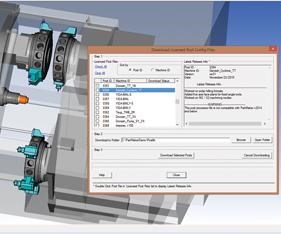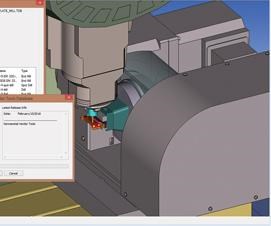The Digital Driven Machine Shop of the Future
How CAM software, the cloud and the Internet of Things are converging to change the way our industry is doing business.
Manufacturing is beginning to participate in an era of unprecedented interconnectedness brought on by the incredible power of the Internet for storing and distributing data on demand. Buzz phrases such as “the cloud” and the Industrial Internet of Things (IoT) are being touted in many segments of the economy including manufacturing, and many businesses are exploring their potential usefulness. What might be less familiar to many manufacturers is what these terms really mean, and more importantly, what impact they might have on shops today and in
the future.
The cloud refers to a type of Internet-based computing, where shared resources, data and information are provided to computers and other devices on demand. Essentially, cloud computing refers to any sort of computer usage where data is being stored elsewhere, such as in a third-party data center.
Data accessed from the cloud or applications being run in the cloud are not obviously occurring in the heavens, but on some computer residing elsewhere that enables connection of a company’s in-house device to a PC, tablet or phone via the Internet. The two biggest benefits of cloud computing are the ability to offload vast quantities of data storage and complex computations to servers that do not need to reside physically within the company. The cloud computer is likely far more powerful and has much more data storage capacity than might otherwise be needed for direct data access within the organization. The cloud offers services at a fraction of the cost of owning and maintaining a similar power in house.
IoT is the network of physical objects—devices, vehicles, buildings and other items that are embedded with electronics, software, sensors and network connectivity—that enables these objects to collect and exchange data.
CAM and the Cloud Today
The cloud is already impacting CAM software. Forward thinking developers of CAM software are already harnessing the power of the cloud to help their users to be more productive in some subtle yet innovative ways. A number of CAM developers such as Delcam, a Division of Autodesk, have been delivering software updates to its users via the cloud for years, perhaps so long that the company was doing so before “the cloud” was a popular term.
Today, Delcam’s PartMaker leverages the power of the cloud in CNC machine integration and tooling selection to provide its end users benefits that have a direct and positive impact on productivity.
The software provides more productive machine tool integration via the cloud by turning to cloud computing to automatically deliver the most up-to-date postprocessor and full machine simulation files to users, on demand, for their shops’ exact line-up of multi-axis machine tools. Using a mechanism within the software’s licensing scheme, the company can know exactly which machine/control combinations are present on a user’s shop floor and can make available to them an exact and an updated postprocessor match for those machines to assure a high degree of accuracy in NC code generation. At the same time, PartMaker also provides the user the correct 3D full machine simulation files for those machine tools.
This approach to postprocessor distribution, which wouldn’t be possible without the cloud, solves a number of problems that have plagued CAM users for years. First, this approach to postprocessing assures the user that they only have access to postprocessors for their exact machine tools, where a machine tool is defined by a particular kinematic architecture and CNC control make and model.
Many CAM systems still take a slightly generic approach to postprocessors—the utilities associated with CAM software that convert the geometric and process data inside a CAM system into a G-code program that will run on a CNC machine. The quality of the postprocessor is the most ubiquitous complaint that users of every CAM system have.
Many such complaints arise because the user has chosen the wrong postprocessor. By using the cloud to determine a user’s postprocessing needs automatically, the possibility that postprocessor errors occur because of mismatched postprocessors to the machine tool is eliminated.
Another major benefit of this cloud approach to postprocessor distribution is that it assures the users that they always have access to the latest postprocessor for their machine tool on demand, without having to interact with the software provider’s technical support team. Postprocessor maintenance is one of the major aspects of software development for PartMaker, which is generally a moving target. Such maintenance can take many forms, including ongoing partnerships with machine tool builders to improve postprocessor quality or updating postprocessors to support new functionality added to the software. These improvements provide a dynamic benefit to end users when they can access them as needed, and the cloud provides a great platform for doing so.
Another way CAM providers are leveraging the power of the cloud is through partnerships with tooling manufacturers such as Iscar and Kennametal. By interfacing behind the scenes with these vendors’ own cloud-based tooling catalogs, PartMaker users can directly access the complete tooling libraries of manufacturers when process planning or programming a part. This sort of cloud-based interoperability will be particularly critical as initiatives such as ISO 13399, the newly created global standard for describing tooling data, become globalized.
“Partnering with CAM developers such as Autodesk’s Delcam unit allows us to leverage our own investments in the cloud by putting practical tooling information at the customers’ fingertips when they need it most, when they’re programming their parts,” says T. J. Long, Kennametal’s senior engineering manager for virtual machining and product classification.
Cloud Native or Cloud Connected?
The cases illustrated in this article describe “cloud connected” software applications. In other words, PartMaker is a desktop computer program installed on a company’s PC, which “connects” at a shop to the cloud to execute discreet tasks. Another type of cloud-based application is a “cloud native.”
PartMaker’s developer, Autodesk, a $14 billion engineering software developer, likes to a draw a strong distinction between those two types of applications: Cloud native products are products Autodesk builds from scratch on mobile and web platforms, while cloud-connected products such as PartMaker are more traditional products that connect to the cloud to take advantage of the additional computational and collaborative capabilities offered by the cloud.
Fusion 360 is a cloud native application from Autodesk and the first 3D CAD, CAM and CAE tool of its kind. It connects users’ entire product development processes in a single cloud-based platform, allowing product manufacturers to take a product from design to analysis through CNC machining, all in
the cloud.
CAM and the Cloud Tomorrow
The benefits CAM is providing via the cloud today are a small fraction of what might be achieved in the future as CAM evolves further to the cloud. It is hopeful that in the future, CAM and the IoT will meet in the cloud to enable a closed factory feedback loop and a digital shop floor.
Autodesk is driving this convergence through a recent acquisition it made of a company called SeeControl that develops an enterprise IoT cloud service platform of the same name. This platform is a cloud SaaS (software as a service) offering for IoT device data collection, analysis and application building. It is purely cloud software and is point-and-click so that anyone can use it without having to learn any programming languages or scripts.
“SeeControl can help machine tool builders develop advanced connected product services they can offer around their product,” explains Bryan Kester, Autodesk’s head of IoT and former CEO of SeeControl.
The cloud represents the ideal platform to harvest the benefits offered by applying IoT technology to machine tools. Machine tools can generate a tremendous amount of data that requires supercomputer levels of analysis.
Only the cloud, with servers working in parallel and coordinating, can handle this kind of workload effectively and cheaply. Also, the cloud offers a lot of data services that can be fused into decision-making about how to operate a machine. For instance, if utility prices spiked at a certain point during the day, such a data service can let the shop manager know production will be expensive at that time of day, so scheduling can be adjusted. Through high level math and automation, a shop could make decisions about sequencing or cycling machines in such a way as to optimize energy consumption. Or it could shut down production altogether to
save money.
“We see the CAM software as potentially evolving to the on-machine analytic engine, reporting critical operating data out to our cloud,” Mr. Kester says.
In essence, as manufacturing marches forward into the brave new industrial world based in the cloud, a company’s CAM system, whether it resides on a desktop or in the cloud itself, will probably play a vital role in driving the digital direction of many manufacturing operations. In many ways, that day is already here.
Related Content
Inside the Premium Machine Shop Making Fasteners
AMPG can’t help but take risks — its management doesn’t know how to run machines. But these risks have enabled it to become a runaway success in its market.
Read MoreCNC Machine Shop Employment Positions to Consider Beyond Machine Operators
Many machine shops have open machine operator positions to fill. But does it make sense for shops to also seek automation engineers, IT managers and assembly personnel?
Read MoreHigh-Production Multitasking Becoming More Flexible
Rotary transfer machines remain well-suited for high-volume production, but are now more accommodating to smaller batch sizes.
Read MorePrecision Machining Technology Review October 2023
Production Machining’s October 2023 technology showcase includes some of the latest technology from Tungaloy-NTK America Inc., Renishaw, Walter USA, Seco Tools and Haimer USA.
Read MoreRead Next
Do You Have Single Points of Failure?
Plans need to be in place before a catastrophic event occurs.
Read MoreA Tooling Workshop Worth a Visit
Marubeni Citizen-Cincom’s tooling and accessory workshop offers a chance to learn more about ancillary devices that can boost machining efficiency and capability.
Read More5 Aspects of PMTS I Appreciate
The three-day edition of the 2025 Precision Machining Technology Show kicks off at the start of April. I’ll be there, and here are some reasons why.
Read More
























